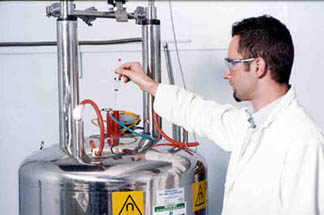|
Introduction NMR spectroscopy is used for the characterisation and identification of solids and liquids. It relies on a fundamental property of atomic nuclei, the spin. Within the instrument, the sample is subjected to two magnetic fields. The first field is produced by a magnet and has a constant intensity. The second field is produced by an electromagnetic radiation source. This latter field is approximately 10,000 times weaker and is variable. Atoms within the sample can absorb this electromagnetic radiation at a given frequency depending on their chemical environment. Complex organic molecules, for example, will contain many atoms in different chemical environments, leading to absorption at numerous frequencies. By noting the intensity and frequency of these absorptions, the NMR spectrum is produced. Interpretation of the spectrum (i.e. intensity, position
& appearance of absorption signals) can assist with detailed
structural analysis of the sample. The technique is most commonly used
for hydrogen nuclei, hence its importance in organic chemistry, though
other nuclei such as carbon-13, phosphorus-31 and fluorine-19 are
routinely studied. Characterisation and identification of solids and
liquids by hydrogen-1, carbon-13, phosphorus-31 and fluorine-19 spectra.
The technique can be utilised for elucidating the chemical structure of
samples and therefore is of great interest to both organic and
biological chemists.
|
||||||||||||||||||

